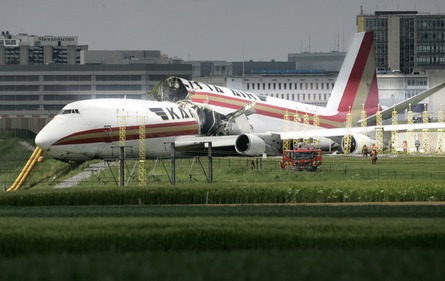Investigators in Brussels have found no evidence of engine damage on the Kalitta Air Boeing 747-200 freighter destroyed in a take-off overrun on 25 May, but confirm that one engine suffered a loss of power at a critical speed threshold.
The Belgian inquiry has also determined that the correct aircraft parameters, runway selection and weather data were uploaded to the 747's computer before departure, and that use of Runway 20 would not have posed any problems.
Two pilots, two engineers and a passenger accompanying diplomatic cargo escaped after the jet broke into three sections during the overrun. There was no prior structural failure the break-up was caused by impact forces as the jet went over a 4m (13ft) drop.
 |
|---|
©Yves Logghe/AP/PA Photos |
"At this stage there is no reason to make urgent recommendations," says the Belgian transport safety agency, which is heading the probe.
Analysis of the flight recorders, it says, shows the initial part of the take-off roll was normal, with constant acceleration until one of the Pratt & Whitney JT9D engines suffered a "momentary" loss of power.
This power loss, which was accompanied by a "detonation", occurred as the aircraft reached the V1 speed - the threshold beyond which a crew normally must commit to becoming airborne, because the aircraft cannot be stopped safely on the runway.
The crew heard the noise and air traffic controllers witnessed flames from the right side of the aircraft.
Two seconds later the engine thrust was reduced to idle and the aircraft decelerated, but failed to stop before the runway end. Thrust reversers were not deployed, although a rejected take-off calculation does not take reverser use into account.
All four engines were operating as the 747 overran and, upon inspection, showed no sign of catastrophic failure. The engine cowlings were not punctured.
Following the indications of a possible problem with one of the right-hand engines, these were subjected to an initial endoscopic inspection of the high-pressure turbine and compressor.
"This inspection, although incomplete, failed to reveal any internal damage," say the investigators. The fan-blades and low-pressure turbine remained in place and were similarly undamaged.
Source: Flight International



















